Here, we present some examples of retinal or chorioretinal disorders that may mimic each other.
The approach to the patient should always begin with a basic, patterned routine for developing a differential diagnosis. In general, chorioretinal processes are considered primarily infectious, inflammatory, infiltrative, degenerative, dystrophic or idiopathic. Although the ophthalmoscopic appearance of many posterior segment diseases may be similar among these processes, careful examination of structural features––along with the use of current imaging––will help you differentiate most lesions.
Chorioretinal Atrophy: Inflammation vs. Degeneration
A number of degenerative, infectious, inflammatory, autoimmune conditions (e.g., the spectrum of “white dot syndromes”) can result in chorioretinal atrophic changes and fibrosis (scarring) that may have a similar appearance, complicating accurate diagnosis.
• Case 1 shows the progression of a patient with high myopia and pathologic chorioretinal atrophy. The ophthalmoscopic findings include peripapillary atrophy and linear chorioretinal atrophy corresponding to a lacquer crack. Over several years of follow-up, the patient developed choroidal neovascularization, which was successfully treated with anti-VEGF therapy. This may be a challenging differential diagnosis, as patients with high myopia, particularly females, may develop white dot syndromes, such as multifocal choroiditis with panuveitis (MCP) and punctate inner choroidopathy. Differentiating between these lesions is best performed with SD-OCT. MCP lesions appear as eruptive pigment epithelial detachments and are elevated RPE lesions. Lacquer cracks and primary atrophic changes appear excavated on SD-OCT. The presence of a cellular reaction in any ocular segment may be helpful but does not rule out chorioretinal inflammation, so we advocate a structural evaluation using SD-OCT.
• Case 2 illustrates a presentation of serpiginous choroidopathy that may be confused with degenerative myopia or peripapillary choroidal neovascularization. In contrast to the lacquer crack and degenerative myopia, this lesion typically begins in the peripapillary region, with symptoms such as photopsia or enlarged blind spot. This patient is not highly myopic, which further narrows the differential diagnosis. In contrast to atrophic or degenerative lesions, the lesions of serpiginous choroidopathy begin in the choroid, and appear as outer retinal and RPE whitening. SD-OCT may also be used for a structural differentiation, as the acute lesions of serpiginous choroiditis demonstrate a diffusely thickened choroid, outer retinal disorganization and subretinal fluid. Nevertheless, the end result of both processes often presents with a similar clinical appearance, with both peripapillary and macular atrophy, often along with choroidal neovascularization.
Mixed Macular Hemorrhage: Choroidal vs. Retinal Vascular
Posterior segment hemorrhage may be due to retinal or choroidal blood vessels. Choroidal neovascularization is the most common cause of subretinal and sub-RPE bleeding. Retinal vascular disease, such as diabetic retinopathy and retinal vein occlusion, typically produce isolated intraretinal and vitreous hemorrhages in the absence of subretinal or sub-RPE blood.
Few disorders include hemorrhage in all three layers—concomitant subretinal, intraretinal and vitreous (or preretinal) hemorrhage. These traditionally include retinal macroaneurysm, the polypoidal choroidal vasculopathy variant of macular degeneration, globe trauma and non-accidental infant trauma (“shaken baby” syndrome). Terson syndrome, or vitreous hemorrhage secondary to a subdural or subarachnoid hemorrhage, is an additional cause of hemorrhage in all three layers and is typically peripapillary. Therefore, the differential diagnosis of multilayer hemorrhage, particularly in a peripapillary location, must include intracranial processes.
• Case 3 llustrates the appearance of a multilayer macular hemorrhage secondary to a ruptured retinal macroaneurysm. This 80-year-old patient, like many over age 65, has a clinical picture that at first glance is consistent with age-related macular degeneration. The presence of a subretinal hemorrhage in the context of adjacent drusen and drusenoid pigment epithelial detachment in the fellow eye is typically present in AMD.
However, the presence of a large area of preretinal (“sub-hyaloid”) hemorrhage is atypical for AMD. The fluorescein angiogram reveals the true pathology to be an underlying retinal macroaneurysm, which is also a common finding in elderly patients with a history of hypertension, particularly those with previous retinal vein occlusion. SD-OCT is again helpful in differentiating these lesions and identifying the location of hemorrhage. The presence of sub-internal limiting membrane hemorrhage is typical of retinal macroaneurysm.
• Case 4 provides an additional example of macular hemorrhage, but with isolated subretinal and sub-RPE hemorrhage. This patient exhibits many similar features as those discussed in case 3; however, examination and SD-OCT reveal the absence of preretinal or intraretinal hemorrhage, and the presence of a large pigment epithelial detachment likely indicates a choroidal neovascular process. The differentiating features play a key role because these similar-appearing lesions have distinct clinical management strategies. Although retinal macroaneurysm may be treated initially with anti-VEGF therapy, observation until hemorrhage resolution is typically undertaken until focal laser photocoagulation can be performed, which leads to occlusion of the macroaneurysm and resolution of hemorrhagic and exudative potential. On the other hand, AMD is treated with ongoing anti-VEGF therapy.
Retinal Whitening: Infectious vs. Vascular vs. Congenital
A number of conditions result in opacification (whitening) of the retina. These conditions include infectious and inflammatory retinitis, retinal vascular occlusions and certain congenital disorders. In addition, infectious and infiltrative processes of the choroid may lead to secondary retinal and RPE whitening. SD-OCT is particularly helpful in this context because the tissue responses to ischemic, infectious and infiltrative processes are both limited and distinct. The structural findings observed help differentiate diagnoses that share a similar ophthalmoscopic appearance.
• Case 5 highlights the typical appearance of a branch retinal artery occlusion. Retinal whitening is seen in a geographic distribution corresponding to a specific retinal arteriole. There are few conditions in which SD-OCT alone is diagnostic and highly specific; the presence of inner retinal hyper-reflectance, as demonstrated, is highly specific for arterial occlusion. Therefore, systemic evaluation for vasculopathy and cardiac disease is indicated.
• Case 6 demonstrates a similar clinical picture as that described in case 5, yet the lesion has a yellow-white appearance and does not have geographic borders corresponding to a specific retinal arteriole. The structural alterations seen on SD-OCT also appear distinct. Instead of isolated inner-retinal hyper-reflectance, there is intraretinal edema and disorganization of retinal layers. This structural feature is consistent with infectious retinitis, and the differential diagnosis includes cytomegalovirus retinitis, herpetic (HSV and VZV) retinitis, and toxoplasmosis. The focal posterior pole location without hemorrhage makes the diagnosis of toxoplasmosis most likely. The follow-up examinations revealed resolution of edema and whitening, but retinal atrophy (which is the sequela of infectious retinal necrosis) eventually developed. Notice that the described processes (toxoplasmosis, HSV, CMV) are all predominantly retinal infectious processes, and therefore the structural alteration seen on SD-OCT localizes to disorganization of the retina. In contrast, endogenous endophthalmitis and inflammatory chorioretinitis typically begin in the choroid, and thus SD-OCT reveals additional involvement of the choriocapillaris and subretinal space, with relative preservation of the overlying retinal structure in the early disease course.
• Case 7 demonstrates retinal whitening by a developmental anomaly. In the fetal stages of a developing eye, myelination of optic nerve fibers is produced by neuroglial cells (oligodendroglia). This process normally stops at the level of lamina cribrosa right before birth. But in some cases, the process continues postnatally, extending beyond the optic nerve head. This results in opacification of the nerve fiber and is called myelinated nerve fiber layer (MNFL). In most instances, it is located around or near the optic nerve head, and often presents bilaterally. In isolated cases, myelinated nerve fibers can be seen in the mid- or peripheral retina. The atypical locations and variability of the retinal opacifiction can lead to diagnostic challenges. Functionally, myelinated nerve fiber layer can cause a decrease in visual acuity or field, depending on the location and extent. In most cases, the diagnosis of MNFL can be made clinically; however, imaging techniques can confirm the diagnosis, particularly in uncharacteristic cases. On OCT, these lesions result in RNFL thickening and may cause masking or shadowing of the retinal layers below it. On angiography, MNFL does not alter the flow of blood but can cause obscuring of retinal vessels and masking of underlying structures.
|
Case 1
A 49-year-old white female initially presented in 2007 with an acute posterior vitreous detachment and a retinal tear in the left eye, for which she had focal photocoagulation. The patient’s entering visual acuity was -7.00 20/20 OD and -10+0.75X150 20/40 OS. One year later, she returned with complaints of seeing a spot in the central vision of her left eye. At this point, her visual acuity with contact lenses was 20/30 OS. Examination revealed a juxtafoveal lacquer crack with small, associated choroidal neovascular membrane. She was treated with intravitreous bevacizumab. Over the course of four years, the patient’s left eye has exhibited progression of chorioretinal atrophy and recurrences of choroidal neovascularization (with as-needed treatment) and visual acuity of 20/200, while the right eye has had a stable lacquer crack. |
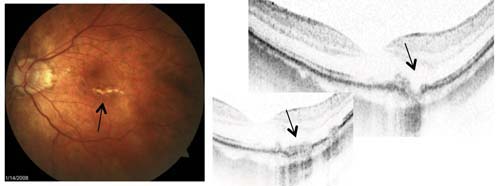
|
| Photograph shows the lacquer crack inferior to fovea. OCT shows views of the crack and CNV. |
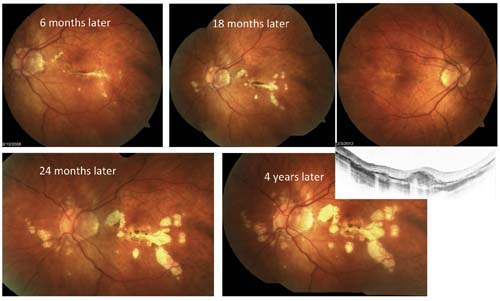
|
|
Serial photos show progression of degenerative myopia with extension of chorioretinal atrophy and Fuchs’ spots.
OCT corresponding to the last photo (inset) shows choroidal thinning, RPE and outer-retinal atrophy and juxtafoveal membrane.
|
|
Case 2
A 42-year-old white female presented in August 2007 for evaluation of peripapillary chorioretinal scars. She had no significant visual complaints and her uncorrected visual acuity was 20/20 OU. Examination revealed that the scars were inactive at that time. We asked the patient to return in two months for close observation; however, she did not come back to the office until a year later, with complaints of floaters. Visual acuity remained 20/20 OU. There was mild angiographic activity OD, and OCT of the area revealed RPE and outer-retinal atrophy. We diagnosed her with chorioretinitis; the differential included serpiginous choroidopathy. We referred the patient for a medical workup and asked her to return in six to eight weeks for close observation. The patient returned two years later with complaints of vision loss OS (20/100; OD remained 20/20). There was significant bilateral progression of chorioretinal lesions, which confirmed serpiginous choroidopathy. Over the next three years, the chorioretinal degenerative process has continued in spite of immunosuppressive therapy. At her latest exam, visual acuity was 20/30 OD and 2/200 OS. |
 |
|
After a year lost to follow up, this patient presented with peripapillary chorloretinal lesions OU. Fluorescein angiography OD showed mild leakage and staining of the lesion inferior to the ONH as well as minimal ONH leakage, while FA OS revealed only transmission defects.
|
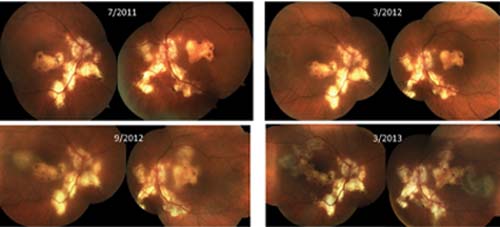 |
|
Two years later, photos and fluorescein angiography show progression of the patient’s chorioretinitis.
|
|
Case 3 An 80-year-old white female was referred for evaluation of wet age-related macular degeneration OD. Her visual acuity measured 20/200 OD and 20/30 OS. Examination revealed a large combined macular hemorrhage OD, and multiple large drusen and pigment epithelial detachment OS. Angiographic study showed the cause of the hemorrhage as a retinal macroaneurysm. |
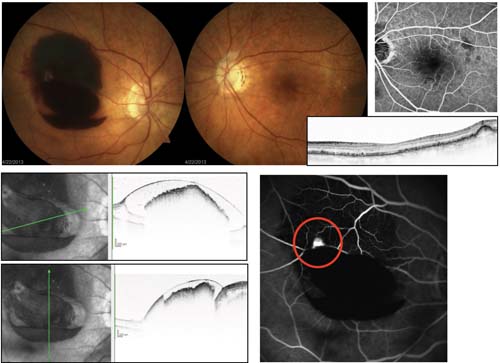 |
|
Photograph of right eye shows mixed retinal hemorrhage. OCT illustrates that most of it is in a subhyaloid location.
Drusen is visible in the photo of
the left eye, and the OCT scan also shows pigment epithelial
detachment. The reflective spot (in the red ring) shown on fluorescein
angiography of the right eye is pooling of the dye by the retinal
arterial aneurysm.
|
|
Case 4
An 86-year-old black female was referred with branch retinal vein occlusion and sudden vision loss OD. The patient (a non-smoker) has been treated for systemic hypertension for 20 years. Her visual acuity was 20/400 OD and 20/40 OS. Examination revealed a mixed macular hemorrhage that was mainly subretinal and sub-RPE in location. The fellow eye had evidence of atrophic age-related macular degeneration. |
 |
|
A large macular hemorrhage was noted OD. Geographic atrophy and drusen were visible OS.
OCT of the right eye shows subretinal and sub-RPE hemorrhage, with a large pigment epithelial detachment and subretinal membrane. |
|
Case 5
A 48-year-old black female was referred for evaluation of branch retinal occlusion. Patient has noticed a dark line inferior to her line of sight OD for two weeks. VA OD 20/20. Medical history was remarkable for systemic hypertension, migraine headaches and cervical cancers during her 20s, now in remission. She was on triamterene/HCTZ, multivitamin with iron, and Imitrex Nasal for migraines PRN. She was placed on daily aspirin regimen and referred for medical work-up. |
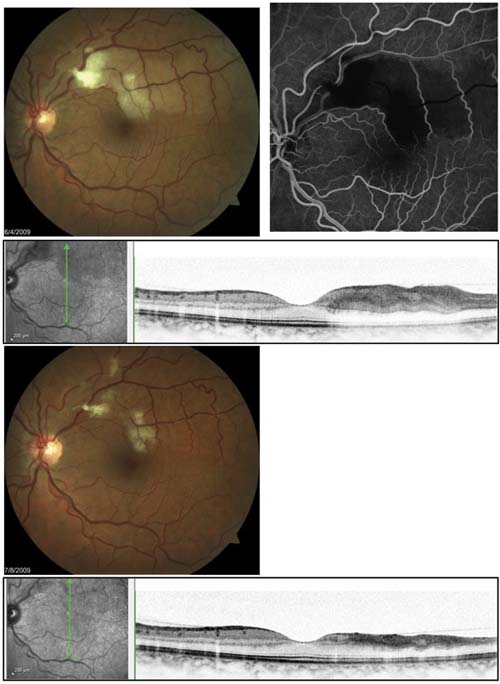 |
|
Retinal whitening along superotemporal vessels corresponds to arterial non-perfusion seen on the FA, also corresponding inner-retinal thickening and hyper-reflectance seen on OCT. Over time, retinal whitening will disappear with normalization of the color of atrophic inner-retina; OCT will then show the corresponding inner-retina atrophy.
|
|
Case 6 A 50-year-old white male was referred for possible branch retinal artery occlusion OD. Patient has experienced vision loss for one day. Visual acuity is 20/400. He is a smoker and is taking Feldene, Cymbalta and Nexium. He has a history of allergic reaction to sulfa drugs. He was started on clindamycin 300mg tid, pyrimethamine 25mg po qd and folinic acid 10mg po qd. His systemic work-up revealed an extremely high quantitiate titer for toxoplasma gondii. His vision returned to 20/30. |
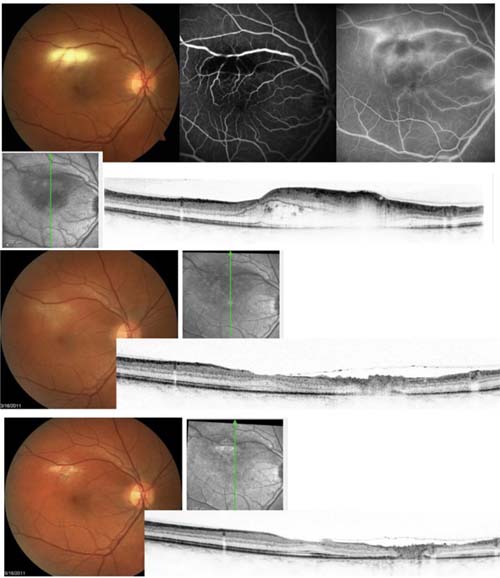 |
|
Photograph shows the infectious retinal whitening. The FA reveals normal arterial flow, with evidence of periphlebitis and mild diffuse retinal and optic nerve head leakage in the involved area. OCT was remarkable for overlying virteous cells; there is thickening of inner retinal tissue with intraretinal and mild subretinal fluid. Over time, the retinal whitening is replaced by retinal atrophy and scarring, seen on photograph and OCT.
|
|
Case 7 A 67-year-old white female was referred for possible branch artery occlusion OS. She has been seeing "dark floater type spots" for three days and is not sure of the laterality of the symptoms. VA OD 20/25 and OS 20/25. She had cataract surgery in both eyes in the past two months prior to the visit. Medical history was remarkable for type 2 diabetes for five years, arthritis, and asthma. |
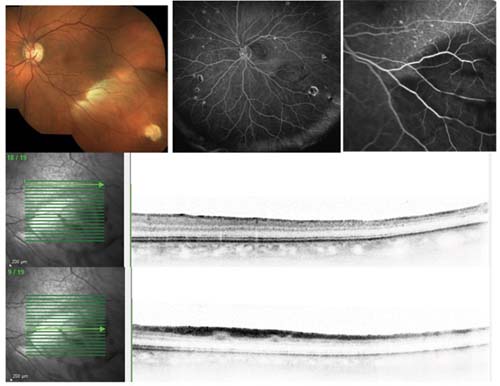 |
|
On photograph, the area of retinal whitening (myelinated nerve fiber) is noted in the mid-peripheral inferotemporal retina. There is an atrophic lesion distal to the retinal whitening. Wide-field FA shows multiple histo-type lesions; however, there is normal arterial flow with mild "masking" hypofluorescence in the same area. OCT of the affected area shows hyper-reflectance and NFL thickening as compared with surrounding normal color tissue. There is also varying degrees of obscuration of underlying structures depending on the density of the myelination.
|
As eye care providers, we encounter a number of challenging cases with very similar presentations yet with different underlying etiologies. Cases presented here highlight the variety of these challenging conditions. These examples also demonstrate how clinical findings combined with imaging, such as OCT, can aid in the proper diagnosis of these conditions.
Dr. Rafieetary is a consultative optometric physician at the Charles Retina Institute in Memphis. Dr. Sigler is a retina specialist at the Charles Retina Institute and an upcoming associate of Ophthalmic Consultants of Long Island, Division of Retina and Vitreous. Dr. Rafieetary is a consultative optometric physician at the Charles Retina Institute in Memphis. Dr. Sigler is a retina specialist at the Charles Retina Institute and an upcoming associate of Ophthalmic Consultants of Long Island, Division of Retina and Vitreous.

